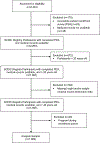Characterising the prevalence of overweight and obese status among adults with sickle cell disease
- PMID: 36382420
- PMCID: PMC9957798
- DOI: 10.1111/bjh.18548
Characterising the prevalence of overweight and obese status among adults with sickle cell disease
Abstract
Individuals with sickle cell disease (SCD) have historically been considered underweight. Despite increasing body mass index (BMI) in the general population, the prevalence of overweight and obese status remains unclear in the adult SCD population. Our primary aim was to determine the prevalence of overweight and obese status and to identify associations between BMI, demographic, and clinical characteristics. We conducted an analysis of abstracted electronic health record data and patient-reported outcomes from the Sickle Cell Disease Implementation Consortium registry; individuals aged 20-45 years were included. The median (interquartile range) BMI for the 1664 adults in this analysis was 23.9 (21.1-28) kg/m2 . In this cohort, 42.9% had a BMI of >25 kg/m2 (Centers for Disease Control and Prevention definition of overweight/obese). In multivariable analysis, higher odds of being overweight or obese were associated with female gender, older age, college education, private insurance, and hypertension diagnosis. Higher odds of a BMI of >25 kg/m2 were observed in individuals with HbSC or HbSβ+ thalassaemia regardless of hydroxycarbamide (hydroxyurea) exposure (odds ratio [OR] 3.4, p < 0.0001) and HbSS or HbSβ0 thalassaemia exposed to hydroxycarbamide (OR 1.6, p = 0.0003) compared to those with HbSS or HbSβ0 thalassaemia with no hydroxycarbamide exposure. These data highlight the importance of early identification, prevention, and intervention for increasing BMI to reduce obesity-related complications that may impact SCD-related complications.
Keywords: body mass index; high BMI; obesity; overweight; sickle cell disease.
© 2022 British Society for Haematology and John Wiley & Sons Ltd.
Figures
References
-
- Centers for Disease Control and Prevention. All About Adult BMI. Centers for Disease Control and Prevention. Published September 17, 2020. Accessed February 1, 2021. https://www.cdc.gov/healthyweight/assessing/bmi/adult_bmi/index.html
-
- Centers for Disease Control and Prevention. Table 26. Normal weight, overweight, and obesity among adults aged 20 and over, by selected characteristics: United States, selected years 1988–1994 through 2013–2016. Published online 2018. https://www.cdc.gov/nchs/data/hus/2018/026.pdf
-
- Farooqui MW, Hussain N, Malik J, Rashid Y, Ghouse M, Hamdan J. Prevalence of Obesity in Sickle Cell Patients. Blood. 2014;124(21):4932–4932. doi:10.1182/blood.V124.21.4932.4932 - DOI
Publication types
MeSH terms
Substances
Grants and funding
- HL133997/HL/NHLBI NIH HHS/United States
- HL134042/MD/NIMHD NIH HHS/United States
- HL133990/HL/NHLBI NIH HHS/United States
- HL133948/HL/NHLBI NIH HHS/United States
- U01 HL133994/HL/NHLBI NIH HHS/United States
- U01 HL134007/HL/NHLBI NIH HHS/United States
- HL133997/MD/NIMHD NIH HHS/United States
- HL133990/HL/NHLBI NIH HHS/United States
- HL133996/HL/NHLBI NIH HHS/United States
- HL133990/MD/NIMHD NIH HHS/United States
- HL133964/MD/NIMHD NIH HHS/United States
- U01 HL134004/HL/NHLBI NIH HHS/United States
- HL133964/MD/NIMHD NIH HHS/United States
- HL133996/MD/NIMHD NIH HHS/United States
- HL133948/MD/NIMHD NIH HHS/United States
- HL134042/HL/NHLBI NIH HHS/United States
- U24 HL133948/HL/NHLBI NIH HHS/United States
- HL133964/HL/NHLBI NIH HHS/United States
- HL133948/MD/NIMHD NIH HHS/United States
- HL133994/MD/NIMHD NIH HHS/United States
- HL134042/MD/NIMHD NIH HHS/United States
- U01 HL134042/HL/NHLBI NIH HHS/United States
- U01 HL133964/HL/NHLBI NIH HHS/United States
- HL133994/HL/NHLBI NIH HHS/United States
- U01 HL133997/HL/NHLBI NIH HHS/United States
- HL133994/HL/NHLBI NIH HHS/United States
- HL133996/HL/NHLBI NIH HHS/United States
- HL133997/MD/NIMHD NIH HHS/United States
- HL134004/HL/NHLBI NIH HHS/United States
- HL133948/HL/NHLBI NIH HHS/United States
- HL133990/MD/NIMHD NIH HHS/United States
- HL133997/HL/NHLBI NIH HHS/United States
- HL133996/MD/NIMHD NIH HHS/United States
- U01 HL133990/HL/NHLBI NIH HHS/United States
- HL134042/HL/NHLBI NIH HHS/United States
- HL133994/MD/NIMHD NIH HHS/United States
- U01 HL133996/HL/NHLBI NIH HHS/United States
LinkOut - more resources
Full Text Sources
Medical



